-
Jefferson, Jeff Park Glacier, July 2 2000: The Bivvy
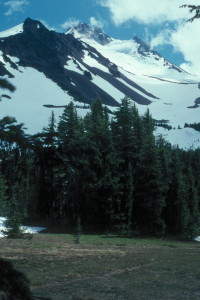
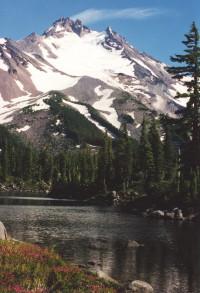
Topo Map of the "route"
TOPO! file (requires topo CD)
Brian Conley writes this intro to my story:
There have only been two occasions that my climbing partner's wife has
called me to tell me about Glenn or ask my advice. The first
time was
after his "bad day at Beacon Rock", where he took a 35 foot lead fall,
pulling out all his protection, bouncing off a ledge, and finally hanging
in his harness at the end of the rope 50 feet above the ground with
a
broken femur. The rescue itself was a convoluted story of other
climbers,
EMTs, trains, ambulances and hospitals. Ah yes, the thrills of
life on
the "Sharp End" of the rope.
This time Glenn was overdue on returning from a climb of Mt. Jefferson,
a
notorious killer in the Oregon Cascades. Patti had gotten a cell
phone
call describing unclimbable routes, clouds and fog, a forced bivouac
in a
crevasse, out of food, and now silence. My exterior self worked
to keep
us both calm. Yes, climbs of Jeff often are caught by darkness
before
returning to camp. And Jefferson Park is a silent hole in the
cellular
phone system. But the possibilities were all too real...
--------
4AM - I realize that the snow on me is getting heavier, and sagging,
and
I'm breathing fast because of the constricted airspace. At least
I can
feel most of my toes again, I haven't been shivering for an hour, and
my
hands are relatively warm...
The trail into Jefferson Park is gorgeous - why have I waited so long
to
come here? The first part climbs through big old-growth, then
it
traverses the south side of a ridge for almost two miles, with stunning
views of the northern aspect of Mt. Jefferson. It's a perfect
day, and as
we scan our route on Jefferson Park Glacier we see that the two big
bergschrunds look passable. We cross a snow bridge on the creek,
near the
broken-down bridge, and shortly are over the last mile of snow and
in
Jefferson Park. Even though it's still 40% snow-covered, it's
beautiful:
early flowers blooming already in boggy meadows, lakes just melting
out,
small sharp-pointed Mountain hemlock breaking up the big expanse of
meadows. It's warm, and I hang my sweaty T-shirt out to dry.
Soon,
though, afternoon clouds close in, and it cools.
My new bivvy bag, light pile sleeping bag, and all my clothes for the
climb are barely enough for the near-freezing temps. I shivver
some
during the night. Good thing we climb early! I ask our
leader, Bob
Brievogel, if he would guarantee no bivvy on the climb, and he replies
that he never has bivvied on the route before. I consider it
a while, and
decide I'll take all my bags and pads "just in case". They don't
weigh all that much.
We wake up at 2AM, and at 3:20 I'm the last out of camp, wandering off
for personal hygiene just as everyone decides they are ready to
depart. When I return, not only are they saddled up, but their
crampons are on! I discover that I should have checked the new
strap
with these boots - it is too long. By the time I figure out how
to
lace them, and punch a new hole, it's 3:40.
Bob chooses a route that heads directly up the snow slope above camp,
then
traverses right over a small lateral moraine and onto the Jeff Park
Glacier. The sun is rising; some clouds, but looks to be a beautiful
day.
Ugh, one crampon has already come loose at the heel due to the steep
snow.

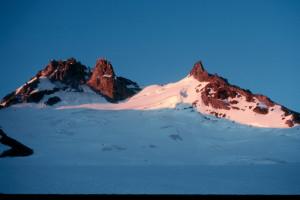
Another 500 feet up, and we rope up, in two teams of three, (I'm middle
man on the second rope with Dave, the assistant, as rope leader, same
position as two weeks ago on Sunshine on Mt. Hood). We continue
up to the
first bergschrund as the sun rises. It's easily bypassed on the
left.
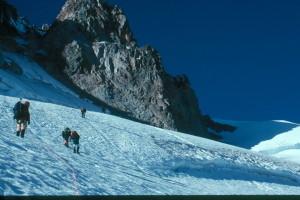
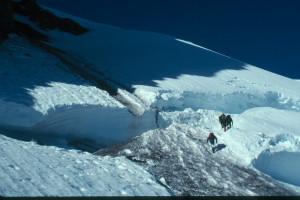
The upper schrund is another matter - the only way across is a small
ramp
and snow bridge, otherwise the schrund at least 5 feet across, and
10 feet
higher the other side. But the bridge is easily crossed.
More steep snow
(to 50 degrees), and we are on the ridge.
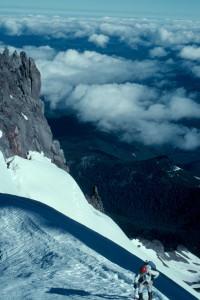
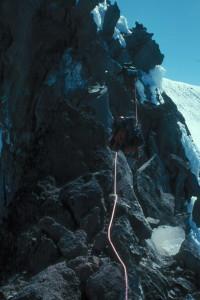
About 11AM, we start the technical work on the ridge - the main section
is
10 feet wide and 200 feet straight down on each side, and mostly snowed
up. The others take their crampons off and on twice to down and
up-climb
the rocky sections; the second time I elect to keep mine on rather
than
struggle with getting them reattached securely. The 5.2 rock
here turns
out to be easier than expected in crampons - I could have done the
prior
short 5.4 section in them. Everyone is belayed at all times,
given the
loose fresh snow and the exposure, so progress is excruciatingly slow.
I
get complaints at some of the cozier belays because my big pack and
bulky
sleeping pad are crowding someone's seat.
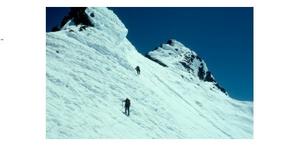
3 hours later, we have finally finished the rocky ridge section, and
can
traverse the rest of the way on snow. It's slow going, requiring
picket
protection most of the way, particularly around one big pinnacle.
We
don't reach the saddle below the summit until 2PM, and I learn that
Bob
has decided that we are too late to tackle the summit pinnacle.
Later, I
learn that as we traversed around the pinnacle he decided that it was
way
too rimed-up to climb anyway. About 5 more protected traverses
get us
around the pinnacle to Red Saddle. Now it's 6PM and clear to
me that we
won't get off the Avalanche Glacier before dark, and a bivvy is a real
likelyhood. I wonder if anyone else in the party has figured
this out
yet, if so, no one is talking about it. As we reach the Red Saddle,
the
clouds that have been dancing just below us for several hours finally
break over us, and the wind picks up.
(About here, my interest in photography wanes...sorry!)
We start down the east side of Red Saddle. Bob traverses a rocky
ledge
over to a steep gully, looks at it a while then comes back. What's
the
deal? Bob says it looks wrong - too steep and suspiciously loose.
So at
7PM we climb a rope-length back up almost to Red Saddle and traverse
south
over to the next ridge. The first rope team cuts the corner and
beats us
over the ridge, and by the time we can see them again, I'm horrified
to
find they are well down the slope and angling southwest, toward another
glacier that I know is the wrong way! I'd yell at them to stop
if I
thought there was any chance they could hear over the rising wind.
We
have no choice but to try to catch up.
In 30 minutes we have descended the snow slope and dropped onto a big
rocky scree field. We keep dropping down, as we see no easy way
back
northeast and over the ridge. Another 30 minutes, and we are
standing at
the top of a cliff! 15 minutes go by while Bob looks around for
a way
down. I'm now very anxious - the only way out looks to me to
be to
traverse back up northeast to the ridge to get back on the snow above
Avalanche
Glacier. We continue traversing the scree west, until at 9PM
we are
standing next to the upper Waldo Glacier.
After a brief and somewhat anxious and heated conversation (Bivvy here?
Not on this slope in this wind!), we get out headlamps and start backing
down the Waldo - looks like we have 600-900 feet of this before the
slope
eases off. About a rope-length down, the lower person on my rope,
John
Cummings, stops and is looking around. I guess that he has missed
the
picket left by the first rope team. Then I see another headlamp
off on
the left of the glacier. I shout at him to try to find out what's
up, but
he has a significant hearing loss which has hampered communications
all
day, and now makes it impossible. Finally I yell at him to just
go on
down to the others, and eventually he does so. I follow, finding
that
they have ducked into a 20-foot-long, 8-foot-deep crevasse for a bivvy.
At least we are out of the wind! I look up to belay Dave down,
and see
that our rope is running up the glacier - gack! John HAD found
the
picket, and I went right past it in the dark! So much for that
picket -
no one volunteers to climb back up to get it.
It's now after 10PM and completely dark, and we are all cold and
exhausted. Dave moves around for a while, then says he is not
warming up,
but too tired to help us dig out a sleeping platform at the moment.
My
silly old long MSR axe now proves quite useful in prying out blocks
of
snow - especially since our only shovel sits uselessly back at camp.
I
ask who has bivvy gear, and am met with silence - only Bob and I have
brought anything but sit-pads! Now I don't regret bringing a
single bivvy
item. I have one of the more difficult choices I've faced on
a climb - do
I share my gear, and risk hypothermia myself? Or do I take advantage
of
my lucky choice and effort to carry all my bivvy gear, and risk having
to
deal with a hypothermia victim? Bob has his pad and down jacket,
nothing
to share. I ponder it as we sort out our small space.
After a half-hour of digging and packing snow we have two ledges - one
barely big enough for four to sit, the other big enough for two to
lie
down. No one should be alone, and Dave seems the most compromised,
so I
tell him I'll share the smaller space and my pile bag with him.
We lay
the ropes down on the big area, I give the other three my two pads
to lay
on that. They set their packs up for a backrest and spread an
emergency
blanket over themselves. Dave and I lay two packs and two sit-pads
down,
spread my open pile bag over us, and I lay my bivvy sack over mostly
me.
Can't give it all away! I have some dry socks, an extra polypro
shirt,
and my shell pants in my stuff sack, but can't summon the energy to
change
or add any clothes. Bob says it's almost midnight by the time
we have our
"beds" made! I'm too tired to even look at my watch.
Within 30 minutes, I'm shivering off and on. We're looking up
at stars,
Dave comments on them, but somehow they aren't making me feel any warmer.
Dave huddles close; it's wierd to feel warm only on 1/4 of your skin.
Soon my left quad starts to cramp, the wind picks up, and I sense a
light
snowfall. Most of the toes on my right foot are numb. Someone
snores for
a few brief intervals - must be Bob in his cozy hole! Finally
at 3AM I
just can't take it any more - I get up to get some blood flowing, take
an
Anaprox, and put on my shell pants. Now it's really snowing,
and the snow
is pouring off the glacier right onto us! Knowing that Dave will
be
getting seriously cold, I crawl back in and try to seal the bivvy bag
over
my head, despite the immediate condensation. I'm a bit warmer,
but I
still start shivering again.
Gradually, I realize that a significant amount of snow is accumulating
-
the bivvy bag is starting to press down on me. But that's fine,
as the
added insulation makes me finally stop shivering.
It starts to get light, and I'm breathing faster - I realize that I'm
partially suffocating under the snow. A brief moment of panic,
then I
decide I can't take it any more, and I suggest to Dave that it's time
to
get up. He agrees, and we make an effort - and don't go anywhere!
Finally with a heave I'm able to get my torso out from under the Bivvy
sack. The snow pours in - it's almost 2 feet deep on top of us!
Many
wriggles later, I'm out, in a heavy stream of blowing, pouring snow.
All
our gear is buried under up to 2 1/2 feet of snow, and it takes us
an
hour to move the snow around, mostly by hand, and find most of our
gear.
My old light pad, sit pad, and half my food are nowhere to be found.
But
the effort is warming us all up, and we quickly get harnessed up.
By 6AM,
we are starting down the glacier again. My pack is really heavy
now, with
the snow and water my bivvy gear has soaked up.
Several rope lengths of slow backing down, and we can turn around and
walk
carefully down the glacier. By 8AM we are at the end of the glacier,
at
7200 feet, in an obvious spot on the map. We doff crampons for
hopefully
the final time, and assess - we must climb back up 1000 feet, over
several
moraines, to a notch in a ridge at 8200 feet to get back onto the
easily-travelled Whitewater Glacier. Fortunately, there appear
to be no
major barriers in our way.
By 10AM we are onto the snow, and we call families before we are due
back to
let them know we will be late. Then we start plodding up and
over the
Whitewater. For a while we are routefinding through crevasses,
sometimes
in only 100 foot visibility. Finally we are onto clear snowfields
- I'm
amazed how huge and relatively flat the northern section of the glacier
is! Plodding back across, we seem to move slower and slower.
I check
that there are no crevasses, then close my eyes off and on. I
have a
vision of camels crossing the sahara - plod, plod.
Finally, around 3PM, the glacier mercifully ends, and we can drink from
a
stream issuing from the snow. What a relief - almost all our
water has
been gone for hours.
A quick series of glissades down the snow-filled gully, and we are onto
bare ground in Jefferson Park. The camp is a very welcome sight
at 4PM.
I tell Bob that no way am I camping again tonight in wet bivvy gear.
Gradually, everyone comes around to the idea that a hasty exit is in
order
- it's raining some, quite cold, and one tent is wet inside.
And the
t-shirt I hung out to dry? Worthless.
The trail out is blessedly uneventful, except that the snowbridge we
crossed coming in is clearly unsafe now - maybe it was before!
We dash
quickly across a shallow area. The last three miles out I'm in
an
exhausted trance - Ed Rea's squeaking boots are hypnotic.
Back at the cars at 8:30 - almost a third night! - Bob gives us all
summit
certificates, despite not actually summiting. Guess we've earned
it just
by surmounting Jeff Park glacier and surviving the ordeal. He
also says
we have all shown we are qualified for a climb like Sandy Glacier Headwall
on Hood. Thanks, Bob, but maybe I'll wait a while!
Topo Map of the "route"
TOPO! file (requires topo CD)








